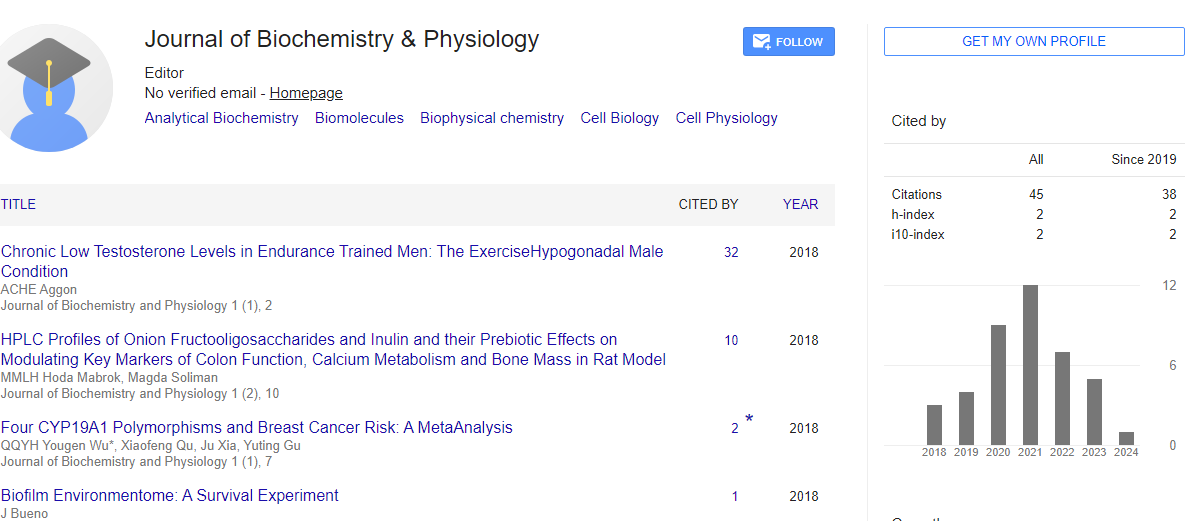Perspective, J Biochem Physiol Vol: 6 Issue: 1
Biochemical Processes of Enzyme-Ligand Interactions
Robin Eruin*
Department of Basic Sciences, King Faisal University, Al-Hassa, Saudi Arabia
*Corresponding Author: Robin Eruin
Department of Basic Sciences, King Faisal University
Al-Hassa, Saudi Arabia
E-mail: robineruin12@gmail.com
Received date: 20-Feb-2023, Manuscript No. JBPY-23-95824;
Editor assigned date: 22-Feb-2023, PreQC No. JBPY-23-95824 (PQ);
Reviewed date: 09-Mar-2023, QC No JBPY-23-95824;
Revised date: 16-Mar-2023, Manuscript No. JBPY-23-95824 (R);
Published date: 23-Mar-2023, DOI: 10.4172/jbpy.1000129
Citation: Eruin R (2023) Biochemical Processes of Enzyme-Ligand Interactions. J Biochem Physiol 6:1.
Description
The enzymes are essential proteins that play a vital role in various biochemical processes in living organisms. From digestion and metabolism to DNA replication and cellular signalling, enzymes act as biological catalysts, facilitating and accelerating chemical reactions that are necessary for life. Central to the functioning of enzymes is their interaction with ligands, which are molecules that bind to enzymes to modulate their activity. Enzymes are highly specific in their function, and their activity can be regulated by a wide range of factors, including ligands. A ligand can be a substrate, a product, or a molecule that regulates the enzyme's activity by binding to its active site or an allosteric site. The active site of an enzyme is a region with a specific three-dimensional structure that accommodates the ligand and facilitates the chemical reaction. The ligand-binding event induces conformational changes in the enzyme, leading to the formation of an Enzyme-Substrate (ES) or Enzyme-Product (EP) complex, depending on the stage of the reaction.
The interaction between an enzyme and its ligand follows a lockand- key or induced fit model. In the lock-and-key model, the active site of the enzyme is complementary in shape and charge to the ligand, allowing for precise binding. The induced fit model suggests that the active site undergoes conformational changes upon ligand binding, resulting in a more optimal fit. Both models highlight the importance of the enzyme's active site and its interaction with the ligand for the formation of a stable complex and the subsequent catalysis of the reaction. Enzyme-ligand interactions are governed by various forces, including hydrogen bonding, electrostatic interactions, van der Waals forces, and hydrophobic interactions. Hydrogen bonding is a prevalent force in enzyme-ligand interactions and plays an important role in stabilising the complex. Hydrogen bonds form between the hydrogen atom of the ligand and the electronegative atom of the enzyme, such as oxygen or nitrogen. Electrostatic interactions, also known as ionic interactions, occur between charged groups of the enzyme and the ligand and can be attractive or repulsive depending on their charges. Van der Waals forces are weak attractive forces that arise from fluctuations in electron density and contribute to the stability of the complex. Hydrophobic interactions occur between the non-polar regions of the enzyme and the ligand and are important in stabilising the complex in a hydrophilic environment.
The strength and specificity of enzyme-ligand interactions are important for the overall function of enzymes. The affinity of an enzyme for its ligand is determined by the strength and number of interactions between them. Higher affinity indicates a stronger interaction, which results in a more stable enzyme-ligand complex. Enzymes can have different affinities for different ligands, allowing for selective binding and regulation of their activity. This specificity is essiential for enzymes to carry out their physiological functions with precision and accuracy. The study of enzyme-ligand interactions has numerous applications in various fields, including drug discovery, bioengineering, and biotechnology. One of the key areas where enzyme-ligand interactions are extensively studied is in drug discovery, where the interaction between a drug molecule and its target enzyme is important for designing effective and selective drugs. Drug molecules act as ligands that bind to enzymes and modulate their activity, either by inhibiting or enhancing their function. By understanding enzyme-ligand interactions, we can design drugs that specifically target enzymes involved in disease pathways, leading to the development of novel therapeutic strategies.
 Spanish
Spanish  Chinese
Chinese  Russian
Russian  German
German  French
French  Japanese
Japanese  Portuguese
Portuguese  Hindi
Hindi 